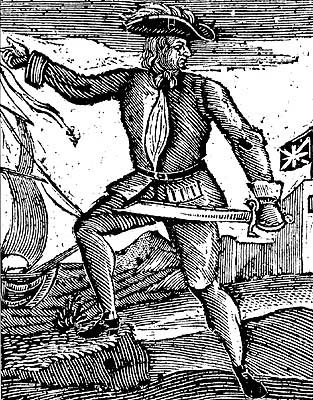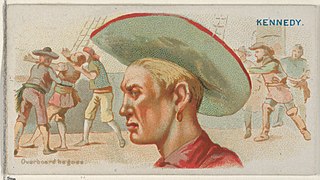This article needs additional citations for verification .(February 2022) |
See also 1718 in piracy, 1720 in piracy, 1719 and Timeline of piracy.
This article needs additional citations for verification .(February 2022) |
See also 1718 in piracy, 1720 in piracy, 1719 and Timeline of piracy.

Bartholomew Roberts, born John Roberts, was a Welsh pirate who was, measured by vessels captured, the most successful pirate of the Golden Age of Piracy. During his piratical career, he took over 400 prize ships. Roberts raided ships off the Americas and the West African coast between 1719 and 1722; he is also noted for creating his own pirate code, and adopting an early variant of the Skull and Crossbones flag.

John Rackham, commonly known as Calico Jack, was an English pirate captain operating in the Bahamas and in Cuba during the early 18th century. His nickname was derived from the calico clothing that he wore, while Jack is a nickname for "John".
John Taylor, born Richard Taylor, was an English pirate active in the Indian Ocean, best known for participating in two of the richest pirate captures of all time.

The Golden Age of Piracy is a common designation for the period between the 1650s and the 1730s, when maritime piracy was a significant factor in the histories of the North Atlantic and Indian Oceans.

Thomas Anstis was an early 18th-century pirate, who served under Captain Howell Davis and Captain Bartholomew Roberts, before setting up on his own account, raiding shipping on the eastern coast of the American colonies and in the Caribbean during what is often referred to as the "Golden Age of Piracy".

Charles Vane was an English pirate who operated in the Bahamas during the end of the Golden Age of Piracy.

Howell Davis, also known as Hywel and/or Davies, was a Welsh pirate. His piratical career lasted just 11 months, from 11 July 1718 to 19 June 1719, when he was ambushed and killed. His ships were the Cadogan, Buck, Saint James, and Rover. Davis captured 15 known English and French ships.

Olivier Levasseur, was a French pirate, nicknamed La Buse or La Bouche in his early days for the speed and ruthlessness with which he always attacked his enemies as well as his ability to verbally attack his opponents. He is known for allegedly hiding one of the biggest treasures in pirate history, estimated at over $1 billion, and leaving a cryptogram behind with clues to its whereabouts. He is also the inspiration for the king of the pirates, Gol. D. Roger
Jeremiah Cocklyn, better known by the name Thomas Cocklyn, was an English pirate known primarily for his association with Howell Davis, Olivier Levasseur, Richard Taylor, and William Moody.

Walter Kennedy was an English pirate who served as a crew member under Howell Davis and Bartholomew Roberts.
Christopher Moody (1650s-1722) was a pirate as a member of Bartholomew Roberts' crew but was never a captain in his own right. He is best known not for his own actions but for a popular Jolly Roger flag mis-attributed to him as well as for later authors confusing him with unrelated pirate William Moody.
See also 1717 in piracy, 1719 in piracy, and Timeline of piracy.
See also 1719 in piracy, 1721 in piracy and Timeline of piracy.
William Snelgrave (1681–1743) was an English sea captain, slave trader, and ivory trader on the West African coast.

The capture of John "Calico Jack" Rackham was a single-ship action fought between English pirate Calico Jack and British privateer Jonathan Barnet. The battle was fought in the vicinity of Negril, Jamaica and ended with the capture of Rackham and his crew.

The Battle of Cape Lopez was fought in early 1722 during the Golden Age of Piracy. A Royal Navy ship of the line under the command of Captain Chaloner Ogle defeated the pirate ship of Bartholomew Roberts off the coast of Gabon, West Africa.

The Flying Gang was an 18th-century group of pirates who established themselves in Nassau, New Providence in the Bahamas after the destruction of Port Royal in Jamaica. The gang consisted of the most notorious and cunning pirates of the time, and they terrorized and pillaged the Caribbean until the Royal Navy and infighting brought them to justice. They achieved great fame and wealth by raiding salvagers attempting to recover gold from the sunken Spanish treasure fleet. They established their own codes and governed themselves independent from any of the colonial powers of the time. Nassau was deemed the Republic of Pirates as it attracted many former privateers looking for work to its shores. The Governor of Bermuda stated that there were over 1,000 pirates in Nassau at that time and that they outnumbered the mere hundred inhabitants in the town.
William Moody was a London-born pirate active in the Caribbean and off the coast of Africa. He is best known for his association with Olivier Levasseur and Thomas Cocklyn, crewmembers who succeeded him as captains in their own right.

John Leadstone was a pirate and slaver active off the west coast of Africa. Often called “Captain Crackers” or “Old Captain Cracker,” he is best known for his actions against the English Royal African Company and for his brief involvement with Bartholomew Roberts.

The Proclamation for Suppressing of Pirates was a royal proclamation issued by George I of Great Britain on 5 September 1717. It promised a pardon for acts of piracy committed before the following 5 January to those pirates who surrendered themselves to the correct authority before a deadline. Originally, the surrender had to occur on or before 5 September 1718; this was later extended by a second proclamation to 1 July 1719.